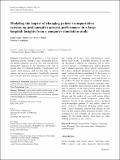Modeling the impact of changing patient transportation systems on peri-operative process performance in a large hospital: insights from a computer simulation study
Author(s)
Segev, Danny; Dunn, Peter F; Sandberg, Warren S; Levi, Retsef
Download10729_2012_Article_9191.pdf (373.2Kb)
OPEN_ACCESS_POLICY
Open Access Policy
Creative Commons Attribution-Noncommercial-Share Alike
Terms of use
Metadata
Show full item recordAbstract
Transportation of patients is a key hospital operational activity. During a large construction project, our patient admission and prep area will relocate from immediately adjacent to the operating room suite to another floor of a different building. Transportation will require extra distance and elevator trips to deliver patients and recycle transporters (specifically: personnel who transport patients). Management intuition suggested that starting all 52 first cases simultaneously would require many of the 18 available elevators. To test this, we developed a data-driven simulation tool to allow decision makers to simultaneously address planning and evaluation questions about patient transportation. We coded a stochastic simulation tool for a generalized model treating all factors contributing to the process as JAVA objects. The model includes elevator steps, explicitly accounting for transporter speed and distance to be covered. We used the model for sensitivity analyses of the number of dedicated elevators, dedicated transporters, transporter speed and the planned process start time on lateness of OR starts and the number of cases with serious delays (i.e., more than 15 min). Allocating two of the 18 elevators and 7 transporters reduced lateness and the number of cases with serious delays. Additional elevators and/or transporters yielded little additional benefit. If the admission process produced ready-for-transport patients 20 min earlier, almost all delays would be eliminated. Modeling results contradicted clinical managers’ intuition that starting all first cases on time requires many dedicated elevators. This is explained by the principle of decreasing marginal returns for increasing capacity when there are other limiting constraints in the system.
Date issued
2012-02Department
Sloan School of ManagementJournal
Health Care Management Science
Publisher
Springer-Verlag
Citation
Segev, Danny, Levi Retsef, Peter F. Dunn, and Warren S. Sandberg. “Modeling the Impact of Changing Patient Transportation Systems on Peri-Operative Process Performance in a Large Hospital: Insights from a Computer Simulation Study.” Health Care Management Science vol. 15, no. 2 February 2012, pp. 155–169.
Version: Author's final manuscript
ISSN
1386-9620
1572-9389